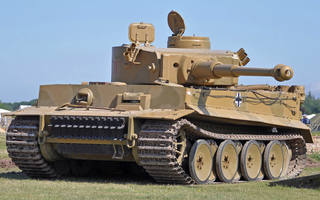Ferry range for the Mustang is over 2,000 miles. Combat range for the Mustang is 1,650 miles with the original smaller drop tanks (and later in the war, they created 110 gallon drop tanks for use in the Pacific). Your 1,400 mile figure for the Mustang is either an error or maybe with a combat load including bombs and rockets.
The Wikipedia entry says differently.
The 1400 mile figure is the nautical mile range with drop tanks, as I specified.
The 110 gallon drop tanks weren't created until the very late stages of the war and I don't believe were used in Europe (nor would there be much reason for it). That's the only reason the range was pushed over 2000 miles and it applied to the Pacific theater.
I also think you're mixing up variants.
I think you're using nautical miles and miles interchangeably. They're different things.
Also in terms of dogfighting, the D and later Mustangs with their bubble canopies gave their pilots far better vision than the Spitfire pilots (who didn't get bubble canopies till after the war).
This is inaccurate. The XIV Spitfire (and subsequent versions too) had a bubble canopy.
Ideal for what? A 1 v 1 short dogfight at high altitude where endurance doesn't matter? Or ideal for winning a war? Your poll question was "best". The "best" is the war winner. And again, none of those German pilots flew in or against a P-47 N with longer range than the Mustang, greater firepower, higher speed, higher ceiling, faster dive, heavier payload, far greater survivability, far greater pilot comfort, and easier to produce.
Ideal for combat. Which all the combatants seemed to agree who the winner was and you're wanting to dismiss it entirely.
Defining "best" as "war winner" is you "Reving."
The Germans flew against plenty of P-47s, come on now.
I have no idea why they didn't rate it higher (because it was a great platform), but they pretty clearly feared the Spit and the Mustang more.
No, you're putting waaay too much on their opinions because they are only talking about a single, exceedingly narrow scenario.
Most all dogfights took place at lower altitudes under 20k feet--even the ones that took place on bomber escort missions.
Fighters merged all the time into combat engagements during WWII. Look up how many planes the Mustang, Spitfire, P-47, Lightning shot down. The number is in the thousands for every plane.
"Exceedingly narrow" my ass: combat engagements occurred all the time where things like firepower, horsepower, climb, acceleration, roll rate, etc. all mattered.
This is "Reving". You're moving the goalposts. The question was the "best". You're changing the question to "who the enemy would rather fly against". Those are fundamentally different questions. Stop trying to win arguments by changing the parameters to suit yourself.
You're the one doing this. Defining "best" as "easiest to produce" among other largely unrelated things. This isn't a conversation about logistics, it's measuring the planes itself.
On pure performance, the Spitfire had the edge in most categories--which made a difference in combat and why all the combatants seemed to agree what the "best" was.
Again...exceedingly narrow scope. You keep harping on this and you're trying to change the whole question to cater to this. Just stop. The question is "best" WWII fighter. The best is the one I can make the most of and be most effective in the various and multiple scenarios where a fighter plane is needed. The correct answer is Mustang for big picture or if you want to get into late-war iterations the correct answer is the N version of the Thunderbolt.
The Spitfire fought throughout the war in all theaters and racked up impressive kills.
At least one author added up confirmed Spitfire kills from known Commonwealth aces and found it to be the plane with the highest number of kills in the war (slightly edging the Mustang, which has always been presumed to be first).
By 1944 and 1945, Spitfires were tasked with bomber escort (especially the Griffon-engined varients) and the number of Commonwealth aces from this period show it was just as valuable as the Mustangs and P-47s in clearing the skies of German fighters.
The Spitfire was the best interceptor of the war and the best dogfighter by some distance. It wasn't even close to the best long-ranged fighter, but later variants that had improved range were also utilized as bomber escorts (the principle strength of both the Mustang and Thunderbolt). By your own definition (being the best across multiple scenarios), being #1 in two of the 3 categories would seem to be a decisive edge over the two you mentioned (and over any other offering).



 But yes, the T-34 was durable, maneuverable, well-armed, and ultimately produced in superior numbers.
But yes, the T-34 was durable, maneuverable, well-armed, and ultimately produced in superior numbers.